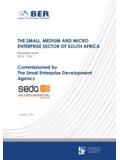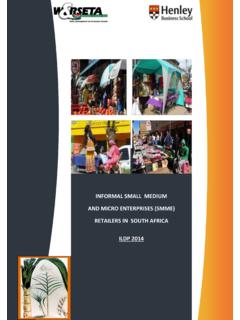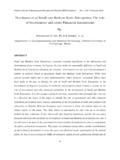Transcription of Health and safety in the small to medium-sized enterprise
1 Health and safety Executive Health and safety in the small to medium sized enterprise Psychosocial opportunities for intervention Prepared by Heriot Watt University for the Health and safety Executive 2007 RR578 Research Report Health and safety Executive Health and safety in the small to medium sized enterprise Psychosocial opportunities for intervention Terry C Lansdown, Carolyn Deighan & Chris Brotherton Applied Psychology Heriot Watt University Edinburgh EH14 4AS The project was commissioned in response to the HSE competition for ideas for research in 2001. The project aimed to identify psychosocial factors which are effective in the maintenance and improvement of Health and safety by the SME. The report outlines the work undertaken to achieve this aim.
2 It describes three key activities: a review of the literature; telephone interviews with stakeholders; and a questionnaire survey. This project sought to identify what SMEs do about Health and safety , what prevents them from doing Health and safety , and what would encourage them to undertaken more Health and safety . The project aimed to elicit views from stakeholders, identify the positive steps presumed to be undertaken, quantify the basis for presumed effectiveness of measures, and to provide recommendations regarding dissemination of these effective actions in support of good safety and Health practice. This report and the work it describes were funded by the Health and safety Executive (HSE). Its contents, including any opinions and/or conclusions expressed, are those of the authors alone and do not necessarily reflect HSE policy.
3 HSE Books Crown copyright 2007 First published 2007 All rights reserved. No part of this publication may be reproduced, stored in a retrieval system, or transmitted in any form or by any means (electronic, mechanical, photocopying, recording or otherwise) without the prior written permission of the copyright owner. Applications for reproduction should be made in writing to: Licensing Division, Her Majesty s Stationery Office, St Clements House, 2 16 Colegate, Norwich NR3 1BQ or by e mail to hmsolicensing@cabinet ii Acknowledgements The project team would like to thank Nicky McGarry from IOG (Institute of Groundsmanship) Scotsturf and Mark Saunders from Clarion Events for their substantive support in facilitating data collection during the project.
4 Iii iv Executive Summary This project was funded by the Health & safety Executive. It was undertaken as part of research contract 4526 The project aimed to identify psychosocial factors in the maintenance and improvement of UK SME Health & safety . There were three key activities, i) a review of the literature, ii) a series of telephone interviews with stakeholders, and iii) a questionnaire survey exploring established issues in more detail. The literature review provided general background to the Health & safety position for the SME. Their characteristics were described with respect to the larger enterprise . Constraints to good Health and safety and opportunities to improve engagement were considered.
5 The practical difficulties in eliciting information from this user group were considered. A lack of effective sector-independent Health & safety solutions was identified and the need for user-focussed approaches emphasised with particular reference to the direct economic benefits to the SME. Fifty cold call telephone interviews were conducted to elicit stakeholders views regarding current activity, perceptions of constraints to further activity, and enabling factors in their Health & safety efforts. Analysis of the telephone interview indicated that there were two broad groups with respect to engagement, a pre-contemplative group and a maintaining one. Results suggest that this is particularly prevalent during the processes predominantlyexternal to the business, , the buying and selling phases of business activity.
6 The main reasons given for engagement in Health and safety activity were legislation, customers demands or safety , staff welfare, insurance and presence of a business Health and safety policy. Key facilitators were highlighted. These included, training, knowledge, a Health and safety policy, company ethos, and accessibility of Health and safety information. During the second data collection activity, a questionnaire survey was developed using key SME Health and safety behaviours and Health and safety -related attitudes derived from the telephone interviews. Three hundred & thirteen SMEs responded to questionnaires distributed at trade shows in Scotland and England.
7 Overall, the level of Health & safety activity undertaken by SMEs was reported to be low (with 59% spending one hour or less in a typical week, the figure was 60% for the telephone interviews). A number of theoretical frameworks were applied during the project. The heterogeneous nature of the SME required a model by which to make comparisons between common business practices. Therefore, a generic business activity model was adopted and proved useful to identify process-specific Health and safety behaviours and examine their frequency within the sample. A further framework was used to assess SME readiness to engage in Health and safety activity. Throughout the project, the model was successful in discriminating engagement.
8 In the both the telephone interviews and the questionnaire survey, SMEs appear to be divided into several groups in terms of engagement with Health & safety , from those that are clearly not engaged to those who are well engaged. Furthermore, those SMEs who were in the later stages of engagement spent significantly more hours per week on Health and safety activity. These findings provide significant support for the utility of the Stage of Change model in a Health and safety context. The consequence of size of the SME was explored. Smaller businesses notably the micro business, spent significantly less time on Health and safety activity compared with larger organisations. Those spending approximately one day per week or more on Health and safety activity were found to be the largest SMEs in the sample.
9 Businesses were statistically more v likely to be in the advanced stages of change, , preparation, action or maintenance phases, as the size of the enterprise increased. Hierarchical regressions performed on the survey data highlighted five key predictors of Health and safety activity. These were positive and negative beliefs regarding resources, relationships with suppliers, and decision making by middle and junior level staff. It is notable that after taking into account the influence of the size of the company, these factors remained of significant importance. This suggests that the influence of these factors pervades despite previous findings related to the size of the SME.
10 Results suggest that concerns regarding the consequences of Health & safety behaviour tend to lead to increased activity. Further, organisational design was found to mediate this effect. SMEs were classified into three groups, i) the unaware-inactive, ii) the anxious-active, and iii)the confident-active. It is suggested that interventions may be targeted to meet the differing needs of these three groups. Thus, although there is a low level of Health & safety engagement by many SMEs, by careful identification of their characteristics, they may be provided with practical solutions to encourage and support their efforts to develop a healthy & safe workplace. vi CONTENTS EXECUTIVE SUMMARY 1 INTRODUCTION 1 2 PART ONE: LITERATURE REVIEW 3 The SME 3 New Challenges for the SME 4 Constraints to Good Health and safety 5 Improving safety & Health in the SME 9 Theoretical Frameworks 24 Summary 27 3 PART TWO: TELEPHONE INTERVIEWS 31 Introduction 31 Method 31 Results 33 Discussion of Results 44 4 PART THREE: QUESTIONNAIRE SURVEY 47 Introduction 47 Method 47 Results 48 Discussion of Results 54 5 DISCUSSION 59 6 RECOMMENDATIONS 63 7 CONCLUSIONS 65 APPENDICES 67 REFERENCES 87 vii viii 1 Introduction This report was funded by the HSE-supported project 4526 The project was commissioned in response to the HSE competition for ideas for research in 2001.

















